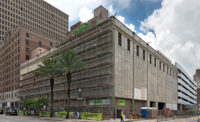Historic Navy Yard Site Brought Into New Century












BNYDC, which aims to make the yard itself a green manufacturing center, has so far signed up two tenants that will do their own interior build-outs. They are Crye Precision, a body armor manufacturer that also has a line of fabrics made from locally recycled materials, and Macro Sea's New Lab, an incubator for high-tech green design and prototypes.
Given the age of the structure, "what we haven't seen is a true structural failure," Martin says. "The failures that we've found were the major ones we knew of coming in—the existing grade beams along Morris Avenue were buckling and there were questions over whether the pile caps were sinking." A block of granite for pile caps supports each column, and each pile cap has several piles below it. The team has removed some of the piles and pile caps and replaced them with steel mini-piles and reinforced concrete pile caps as well as reinforced concrete grade beams.
Despite such details, the structure has held up remarkably well, says Richard Wood, Plaza Construction president. "It's really good basic engineering; it's nicely done."
Brooklyn Navy Yard's New Commission
Renovation of the Green Manufacturing Center (GMC) is part of the Brooklyn Navy Yard's latest building program, which during the next two years aims to complete new construction or renovation of 1.8 million sq ft of industrial space—the yard's largest expansion since World War II. The $750-million program itself builds on New York City's $250-million prior investment to replace the yard's water, sewer and electrical lines as well as to rebuild roads, says Andrew Kimball, who until recently served as president and CEO of the Brooklyn Navy Yard Development Corp., a nonprofit that manages the site for the city. He says that between 2009 and 2015, a total of 12 structures will have either been restored or built, and all will be certified LEED Silver or above. This includes the GMC, which he calls a "defining project" for the yard. "For many years it was a defining project of urban decay," Kimball says. "It was a shed of broken glass with siding that had fallen off—a massive hulking structure sitting as a symbol of a bygone era." The renovation is "bringing it back to life as a model of 21st-century advanced manufacturing." Other recently announced projects include the 1-million-sq-ft renovation of Building 77, a 16-story former ammunition depot that is slated to become a manufacturing and technology innovation hub. Construction of the $80-million project began in May. The structure reinforces the yard's position as part of the Brooklyn Tech Triangle, which includes the Downtown Brooklyn Partnership and the DUMBO Improvement District and focuses on boosting tech jobs in the region, Kimball says.
(Clarification: This story has been amended to reflect the correct target completion date—it is fourth-quarter 2014, not first quarter as was originally reported.)







